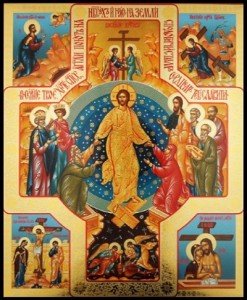In the last installment of this article, I began sharing thoughts about the Prologue of the Gospel John that we heard proclaimed today on Pascha. As it continues, it announces more major themes of John’s Gospel: life, light and enlightenment. The Word is the life of the world and the light of all people, the true light that enlightens everyone. John declares: He became flesh and lived among us. He is, of course referring to Jesus. Jesus is the Word of God become flesh, the real incarnation of the Word, of God Himself.
What John says about Jesus and the Word of God is sometimes truly misunderstood. For many Christians, Jesus and the Word of God have become interchangeable and identical terms. Thus they understand John’s opening words to mean, In the beginning was Jesus, and Jesus was with God, and Jesus was God. But that is not what John says. What was in the beginning with God was the Word/Wisdom of God. But Jesus wasn’t there in the beginning; that which became flesh in him was. Jesus is the embodiment and revelation of what can be seen of the Word/Wisdom of God in a human life.
While this may seem to be just an equivocation, the distinction is very, very important for our understanding of Who Jesus is.
John’s use of symbolic language is extraordinarily powerful. His images are often archetypal (literally, imprinted in human psyches from the beginning). They flow out of the depths of human longing and experience. We see this with great clarity in the I am statements that he attributes to Jesus. John’s symbolic use of language is magnificently signaled in his inaugural story of Jesus’ public activity. At a wedding in Cana, Jesus changed a very large amount of water into wine. (150 gallons – 750 bottles in modern terms). The story in John 2 begins: On the third day, but John provides no chronological context for the phrase. Rather, its meaning is symbolic. Beg things happen in the Bible on the third day, and in particular the phrase points forward to the resurrection of Jesus on the third day.
The next phrase is there was a wedding. Just as the third day has symbolic meaning in the Bible, so also does marriage imagery. For God’s relationship to Israel, the union between heaven and earth, the divine-human union. This, John is saying, is what the story of Jesus is about – the marriage between heaven and earth.

